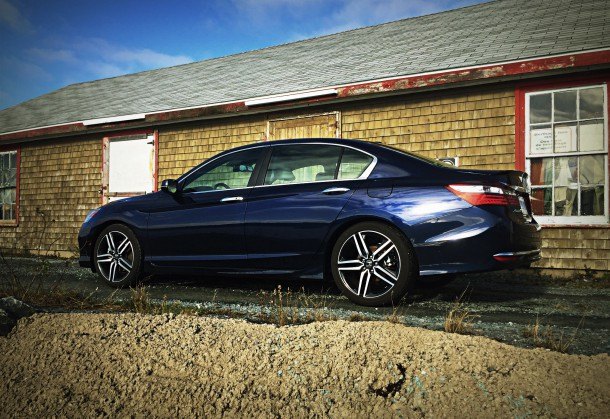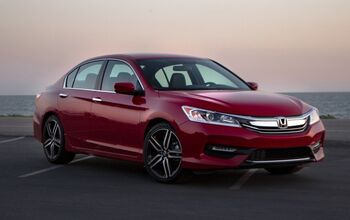2016 Honda Accord Touring Review, By The Numbers
“Very little to dislike,” I found myself responding day after day during my week with the 2016 Honda Accord.
Rarely does a visiting test car generate as many questions and compliments. But the slightly restyled Accord, riding on the Touring’s eye catching, wheel-arch-filling 19-inch wheels, was deemed by friends, family, and neighbours to be quite the looker. And because it’s a car that’s squarely positioned in the affordable realm, they didn’t just compliment the Accord the way they did the $85,000 Audi A6 I drove earlier this fall. Rather, they’d ask, “Would I like it?”
And indeed, there’s very little to dislike about Honda’s refreshed Accord. Perhaps the ride on low-profile 19-inch rubber is too firm for some midsize buyers. The continuously variable transmission, though not nearly as offensive as some examples of the breed, can cause tiresome droning from the engine when accelerating rapidly from rest. And outside of the wonderful Apple CarPlay and Android Auto systems, the touchscreen — with its flush-mounted “buttons” — is not the most intuitive.
Yet sharp handling, an impressive four-cylinder powerplant, decent interior space, and classy exterior styling make the Accord feel like a proper amount of car for the money.
This, however, is not your normal TTAC Accord review. We’re trying something different, and you’re experiencing the experiment in beta guise. My job is to bring you the vital figures and to put those figures in context.
(Keep in mind, this is a Canadian-spec car. Accord Tourings in the U.S. are top-tier Accords with the V-6 engine. In Canada, Touring is similarly the top-end Accord, but it’s available with the four-cylinder engine, a 6-speed manual transmission and is in many ways the Accord Sport with more equipment: same quick steering, same big wheels, but four fewer ponies. Our tester was optioned up with the CVT.)
Horsepower
Optional Horsepower
Fuel Economy
Cargo Volume
Passenger Volume
Rear Legroom
Sales
Length x Width x Height
Curb Weight
Observed Fuel Economy
Steering and Tires
Money
Timothy Cain is the founder of GoodCarBadCar.net, which obsesses over the free and frequent publication of U.S. and Canadian auto sales figures. Follow on Twitter @goodcarbadcar and on Facebook.
More by Timothy Cain
Latest Car Reviews
Read moreLatest Product Reviews
Read moreRecent Comments
- Buickman burn that oil!
- Jkross22 Meant to ask.... what's the best oil to use in a popcorn popper? I've been wanting to try peanut oil, but can't find anything smaller than the huge container at smart n final.
- Ajla A union fight? How retro 😎
- Analoggrotto Finally, some real entertainment: the Communists versus the MAGAs. FIGHT!
- Kjhkjlhkjhkljh kljhjkhjklhkjh *IF* i was buying a kia.. (better than a dodge from personal experience) .. it would be this Google > xoavzFHyIQYShould lead to a 2025 Ioniq 5 N pre-REVIEW by Jason Cammisa




















![2016 Honda Accord Sedan Review - Quintessential Family Hauler [Video]](https://cdn-fastly.thetruthaboutcars.com/media/2022/07/19/9237516/2016-honda-accord-sedan-review-quintessential-family-hauler-video.jpg?size=350x220)














Comments
Join the conversation
FWIW, I'm not liking the new review style at all. I want to read the story of a new car in a way which both informs and entertains. This style, on the other hand, has all the drama of a 1990s user's manual. Life is too short to spend much of it on a "just the facts" style. BTW: Nice photo of an Accord before it rolled backwards into a river after the driver left it in neutral with the brake off :).
Not among the favorites, as far as reviews I've read here; seems like a recap of Alex's initial review, and not much else. I own a 2014 Touring and thoroughly enjoy it; upgraded to the 19" HFPs, which actually made the ride smoother than on the stock 17s. It would have been nice to hear about some of the new features that came along with the refresh, i.e. the suspension dampers from Acura; LKAS and CMBS; the effect the larger wheels have on ride, handling, and fuel economy. Hell, a review of the V-6 6AT model would have been nice, considering Alex's review was on the same trim and Jack's was on the 6-6.